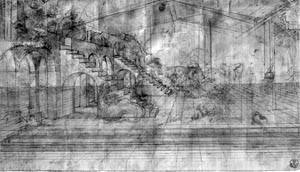Thanks for visiting Art History Abroad’s blog, we hope you enjoy it. We run brilliant Summer and Gap Year courses for students aged 16+. Follow our courses on Instagram or read our ⭐️⭐️⭐️⭐️⭐️ reviews on the GoOverseas review site, or watch our video.
It is often said that the life of Maurizio Seracini is like something out of the Da Vinci Code. He studied bioengineering at Harvard in the 70s before returning to his home, Florence, to develop technology to investigate Florentine renaissance paintings diagnostically and non-destructively. Since then, he has adapted medical and military technology to scan paintings and disclose secrets locked within the layers of paint.
In the 90s he used this technology to scan the walls of the Salone dei Cinquecento in the Palazzo Vecchio to find a lost Leonardo fresco, The Battle of Anghiari, believed to be under the Vasari frescoes that are visible today. More recently, he turned his attention to an investigation of da Vinci’s Adoration of the Magi. What his work uncovered in this latter piece is simply spell binding.
I recently helped to write a chapter in a book to be published about what was discovered. I thought I would share some of my thoughts on what Seracini’s work means for Leonardo da Vinci scholarship and the future of art history.
Leonardo’s enigmatic Adoration is unfinished and in a somewhat unsatisfactory state. The yellowing varnish that covers the entire piece mutes the vibrancy of the forms a great deal. Art historians have long suspected that a hand other than Leonardo’s applied the paint to the work at a later date. The dark brown smears in the foreground certainly seem much cruder than the delicate forms of the congregation.
But despite its unsatisfactory condition, it is clearly a bold work, exhibiting the young Leonardo’s precocious talent. With the painting, Leonardo broke decisively from the moods of pageantry and celebration that Gentile da Fabriano chose for his famous Adoration half a century earlier and instead gave the event a highly unusual sense of troubled urgency. Figures approach the Madonna in a state of unrest, desperately trying to catch her attention or a glimpse of the miraculous occasion. Gone are the dreamy, utopian landscapes of, say, Domenico Ghirlandaio’s Adoration, and instead we have a work that finds a kind of disquiet in the worship of the young Christ. It is a painting, I think, which associates the coming of Christ from the trauma of his crucifixion.
With Seracini’s scans we are able to see Leonardo’s original intentions for the piece. They provide us with unseen Leonardo drawings and a fascinating insight into his compositional process. We are literally able to ‘step into’ the painting.
Notice how the leg of the Virgin is bathed in an ethereal light in the under-drawings. This detail is completely lost in what is visible today. The scans restore a former luminosity to the seated Madonna and a sacred atmosphere to the event. This luminosity perhaps explains why one of the figures to her left appears to be shading his eyes.
Notice how Leonardo thought it necessary to design a much more complete architectural setting in his preparatory sketches. This is a truly remarkable insight into Leonardo’s compositional process: he seems to have felt the need to build the temple first before subjecting it to imaginary ruination. In the discovery of these hidden sketches we can see Leonardo working as a master of naturalistic gesture and anatomy, but also as an architect.
Notice how Leonardo included figures rebuilding the temple in his preparatory sketches. The ruined temple is a common theme in adoration scenes. It is meant to represent the decay of paganism at the birth of Christ. But, its rebuilding displays a desire to preserve, reawaken and revere the forms and ideals of pre-Christian antiquity. It seems Leonardo intended a more complex symbolic duality to the image of the ruined temple. The condemnation of paganism combined with the respect for classical antiquity is after all a contradiction at the heart of all renaissance religious painting.
These are just some of the amazing details you discover when observing Seracini’s scans. I think it is safe to say that his work has changed art history for ever.
Crucially, the scans are not just an important moment for scholarship, but also a deeply pleasurable aesthetic experience.




